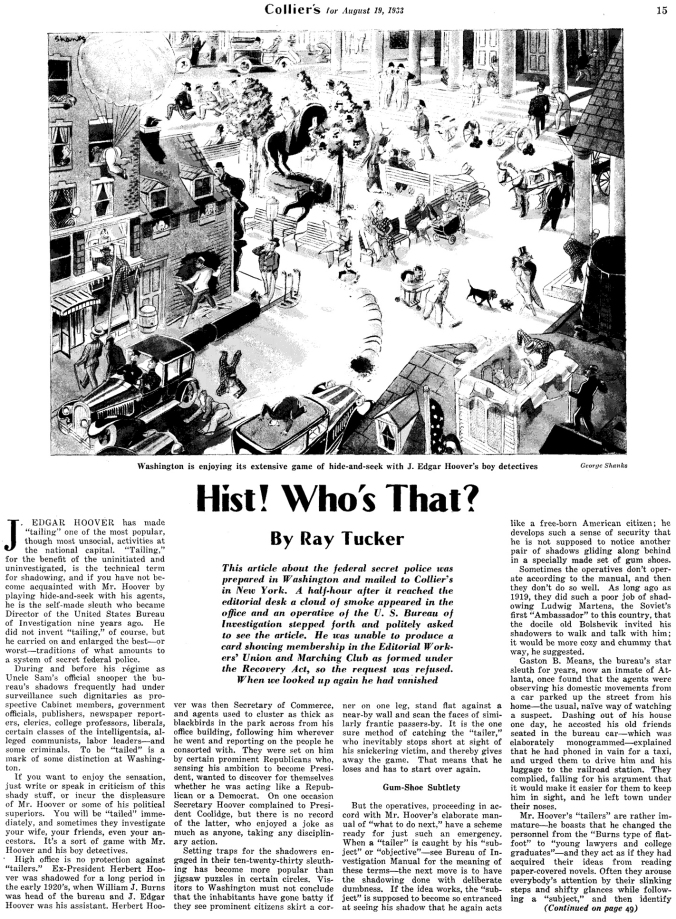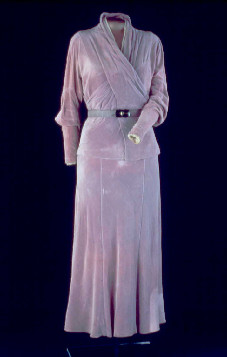
In the August 19, 1933 issue of Collier’s magazine, Ray Tucker offered a scathing indictment of the Bureau of Investigation (forerunner to the FBI). Such a critical take was unsurprising given Collier’s progressive editorial stance. A weekly magazine of news and culture, Collier’s was one of the most popular periodicals in the United States in 1933 with a circulation of 3.7 million. In the course of lambasting the “boy detectives” of the BOI for their domestic surveillance operations, Collier’s made one of the earliest print references to the oft-debated sexuality of the Bureau’s young director, J. Edgar Hoover.
In appearance, Mr. Hoover looks utterly unlike the story-book sleuth. He is short, fat, businesslike, and walks with a mincing step… He dresses fastidiously, with Eleanor blue as the favorite color for the matched shades of tie, handkerchief and socks.
“Hist, Who’s That?” has proved of lasting interest to historians primarily because of its loaded description of Hoover. Claire Bond Potter and Richard Gid Powers have pointed to the depiction of Hoover’s “mincing steps” as a particularly caustic nod to his supposedly feminine gait. However, a closer look at the article reveals a bolder allusion to Hoover’s femininity and sexuality than the portrayal of his step, albeit a more hidden one. Collier’s noted that Hoover’s wardrobe was dominated by “Eleanor blue,” a term coined by the press to describe the color of the velvet day-dress that Eleanor Roosevelt had worn to her husband’s inauguration in early March. As most readers of Collier’s would have known, “Eleanor blue” was actually more of a lavender, a shade which by 1933 had already become a euphemism for male homosexuals.

Given this context, we might deduce that the description of Hoover’s preferred sartorial shade was a coded reference to the Director’s rumored sexual preferences. Like much of the gossip surrounding Hoover’s sexuality, it was an accusation hidden in plain sight. Though the average reader of Collier’s might miss the insinuation, those “in the know” would be able to connect the dots and comprehend the deeper critique hidden within the account of Hoover’s “fastidious” dress.
In the mainstream press of 1933, discussions about sexuality were rarely obvious and readers were invited to look between the lines. As it was for Collier’s readers in the 1930s, so it is for historians of sexuality of today who must also strive to reconstruct the constellation of culture to which past readers had access. For historians of sexuality, this process involves listening for hairpins dropping, or in this case, looking out for local color.
This post was corrected on 3 September 2015 to show the 1933 day dress worn by Eleanor Roosevelt to her husband’s swearing-in rather than the one she wore to the 1945 inaugural reception.
 Christopher Michael Elias is a doctoral candidate in the Department of American Studies at Brown University. He is currently at work on his dissertation, which explores the role of masculinity in shaping the national security state by examining the lives and careers of J. Edgar Hoover, Joseph McCarthy, and Roy Cohn.
Christopher Michael Elias is a doctoral candidate in the Department of American Studies at Brown University. He is currently at work on his dissertation, which explores the role of masculinity in shaping the national security state by examining the lives and careers of J. Edgar Hoover, Joseph McCarthy, and Roy Cohn.

NOTCHES: (re)marks on the history of sexuality is licensed under a Creative Commons Attribution-NonCommercial-NoDerivatives 4.0 International License.
Based on a work at www.notchesblog.com.
For permission to publish any NOTCHES post in whole or in part please contact the editors at NotchesBlog@gmail.com





Nice work here, Christopher – thank you. And can’t you just see Hoover in that dress?! I was not aware Collier’s was considered a progressive periodical. They were also responsible for the February 1947 article The Biggest Taboo, which has been credited with helping to reinforce the belief in a link between homosexuality and pedophilia.
Hi Jon,
Thanks for your kind comment. I think Collier’s progressive ethos grew out of its earlier muckraking (Upton Sinclair was a key contributor in the early 1900s), and you can see the same inclination to “expose” in this 1933 article on Hoover. Though I’ve mined it for the sexual angle, it’s largely concerned with impugning the BOI/FBI for their active surveillance programs — Ed Snowden would be proud.
I’d not heard of “The Biggest Taboo” before you mentioned it (http://www.unz.org/Pub/Colliers-1947feb15-00024?View=PDF), but after a quick read even that article appears *relatively* progressive for 1947 — the author is arguing for medical treatment of homosexuals rather than their imprisonment. That such a proposal was regarded as progressive underscores the pervasive homophobia of postwar America.
The larger truth is important but according to the Smithsonian website (http://americanhistory.si.edu/first-ladies/first-ladies-fashions-page-2), the dress in the photo is the one Eleanor Roosevelt wore to the 1945 inaugural reception (no ball, due to wartime). It’s not a day dress — it wouldn’t be full-length or have the spangly sleeves. Here’s the Eleanor blue day dress: http://voices.washingtonpost.com/reliable-source/2009/01/rs-dress26.html. Take it from a gay man…
Thanks for the correction, Chris. We’ll definitely trust a gay man on this! The piece has been amended and the correction noted.
I just read this article on Slate, and will copy here a correction e-mail I just sent to them:
In your story regarding J. Edgar Hoover wearing “Eleanor Blue,” you have a link to one of Mrs. Roosevelt’s inaugural gowns. Two problems: First, the article refers to a day dress she wore to the swearing-in ceremony, and your link shows a ball gown. Here is a link to an article with the correct image of that day dress (and yes, it’s lavender): http://voices.washingtonpost.com/reliable-source/2009/01/rs-dress26.html
Second Problem, the dress you currently link is actually the gown she wore for the 1945 inaugural reception, as there wasn’t a ball that year. For what it’s worth, I don’t know that I would call this one lavender anyway; it’s more of a puce shade.
Interesting tidbit re usage of the term “Eleanor Blue”: A generation earlier, the country was awash in the color “Alice Blue,” named for then-First Daughter Alice Roosevelt, who was a first cousin of Eleanor. There was even a popular song, “Alice Blue Gown.” It could be that the 1933 press was hearkening back to Alice Blue with the use of Eleanor Blue.
Thanks for passing on the correction, and further information, Amy. We’ve amended the post and noted the correction. Cheers!